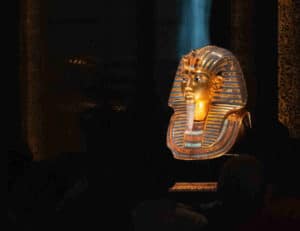If we think of the great temples of Ancient Egypt, such as those of Luxor or Abu Simbel, the color that comes to mind is that of the bare stone used for their construction, generally granite and sandstone, abundant in the south of the country. But, were there colors in the temples of Ancient Egypt? Here we answer and mention some of the most symbolic examples.
Yes, there were colors in the temples of Ancient Egypt.
It may seem surprising to many, but yes: there were colors in the temples of ancient Egypt. But due to the passage of time and neglect, these pigments have been lost in most cases. And we say “in most cases” because there are some magnificent exceptions in which the coloring has reached our days. It has done so in a very delicate state and only in some parts, but this has allowed recent restoration work to restore splendor to these spaces.
Ancient Egyptian temples with colors
If you want to visit and stop at some temples where the ancient colors are especially visible, here are some examples that are also part of many of our circuits.
Temple of Esna
It is probably the most colorful temple in the whole country. And they have been preserved because the hypostyle room, where the colorfulness is concentrated, was buried under the sand deposited during centuries, after its abandonment. This space is decorated with hieroglyphs everywhere, both on the columns and on the walls and ceiling. There is a predominance of tones that are easy to obtain from the earth, such as reddish, brown or yellowish tones, but also others that provide a fascinating counterpoint, coming from less common minerals, such as green or even blue. Construction began in the Ptolemaic period (2nd century BC) and was completed under Roman rule (1st-2nd century AD), so that this late construction has also helped its preservation.
Temple of Edfu
Located near the previous one, it was built entirely during the Ptolemaic period. Here, the coloring is less evident, but it has been recovered thanks to restoration work completed in 2024. In addition, these works have uncovered another important detail in relation to the coloring: certain spaces were covered with copper plates, which provided a characteristic bright golden hue. These plates have not been preserved, but the grooves used to embed them on the wall have been preserved.
Temple of Abydos
Built as a funerary monument to the pharaoh Seti I (XIX dynasty, XIII century BC), the temple of Abydos is one of the most colorful and best preserved. And that gives it a very special value, given its antiquity. Its reliefs show the aforementioned pharaoh in different attitudes, such as making offerings or bowing to different divinities.
Temple of Dendera
Finally, the temple of Dendera is another that we could not overlook, because here the coloring helps to create a really suggestive atmosphere. Its hypostyle hall retains much of its original pigments, in particular the bluish ceiling, which brings a celestial character to the place. Not by chance: this temple, dedicated to Hathor, has a great relationship with ancient astronomy, as evidenced by the large circular zodiac in one of the rooms.
In addition to these four temples, there are many other monuments to know closely the chromatism of the buildings in Ancient Egypt. Especially, tombs such as those that can be visited in the Valley of the Kings, of the Queens and of the Nobles. Undoubtedly, it was a civilization that gave great importance to the symbolic value of colors, as evidenced by the invention of Egyptian blue, which we told you about in this other post.



